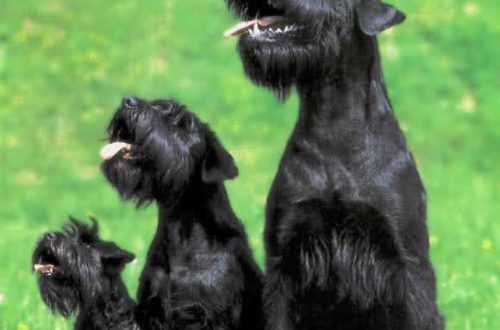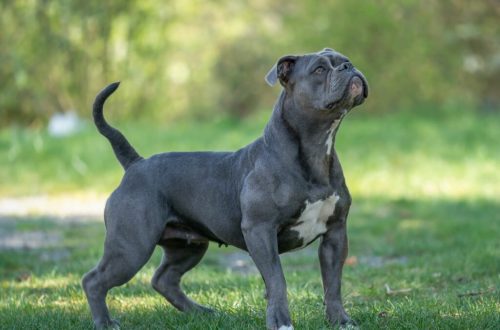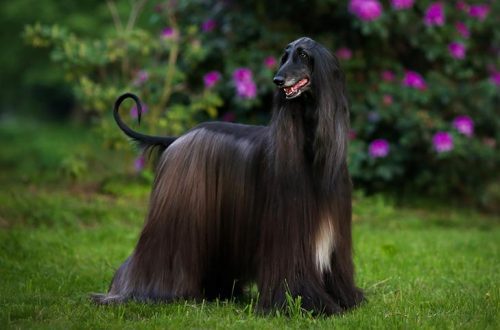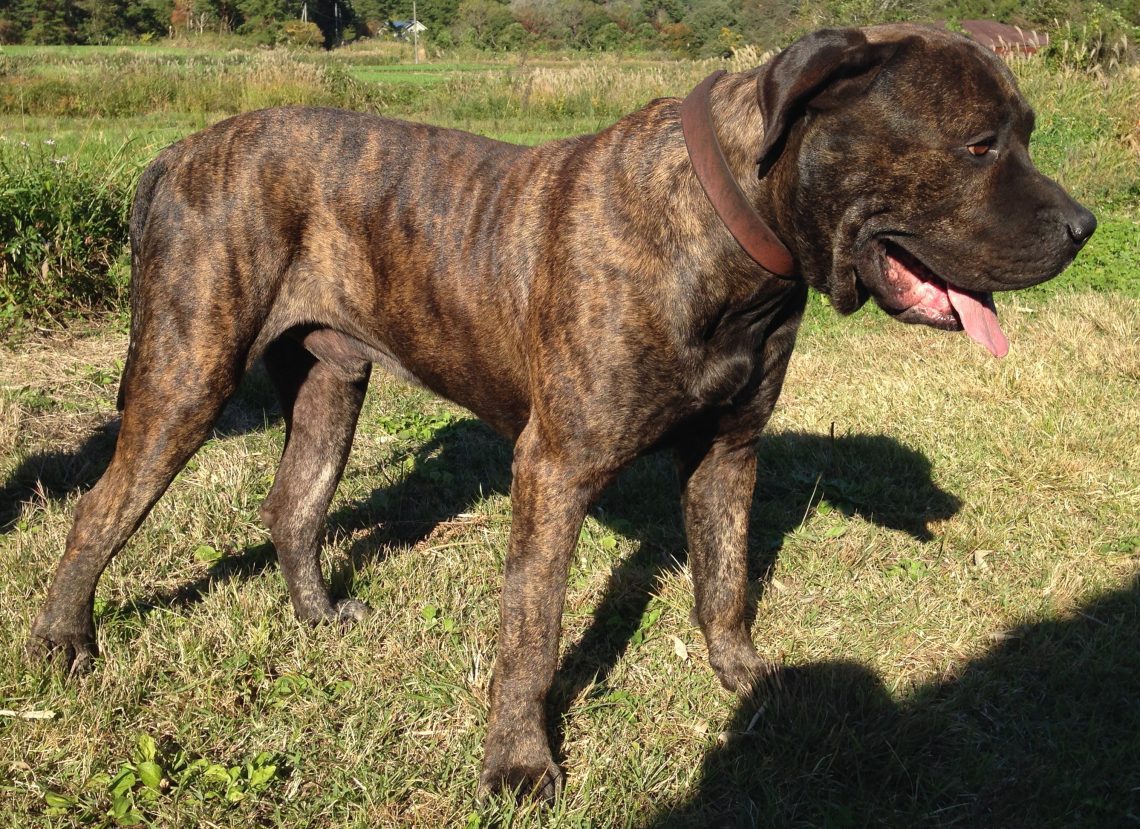
Dogo Canario
Other names: presa canario , dogo canario
The Dogo Canario is a breed of molossoid dogs with keen territorial and watchdog instincts that originated on the islands of the Canary archipelago.
Contents
Characteristics of Dogo Canario
| Country of origin | |
| The size | |
| Growth | |
| Weight | |
| Age | |
| FCI breed group |
Basic moments
- From Spanish, presa canario translates as “a dog that grabs / strangles.”
- The breed is listed as potentially dangerous in a number of countries and is prohibited from being imported into Australia, Malaysia and New Zealand.
- Compared to most fighting dogs, Great Danes have a lower level of aggression, which does not prevent them from overreacting to any threat to humans.
- Presa canario is a dog of one owner, so even living in a large family, the animal will obey the requirements of one person.
- It is useful to involve the breed in weight pulling, but cardio training, including jogging behind a bicycle, is not her forte.
- Canary Great Danes practically do not initiate fights with fellow tribesmen, but willingly participate in them.
- As with any dog with fighting genes, the Dogo Canario will have to bear the brunt of the responsibility of following strict restrictions on walking and being in public places.
- Great Danes do not suffer from the profuse salivation characteristic of their relatives – Neapolitan mastiffs, bulldogs and boxers. An exception is when a delicacy appears in front of the animal’s nose, for some reason it is inaccessible to it.
- The breed still exists in different types, which are difficult to fit into the official FCI standard, which complicates the process of choosing a puppy.
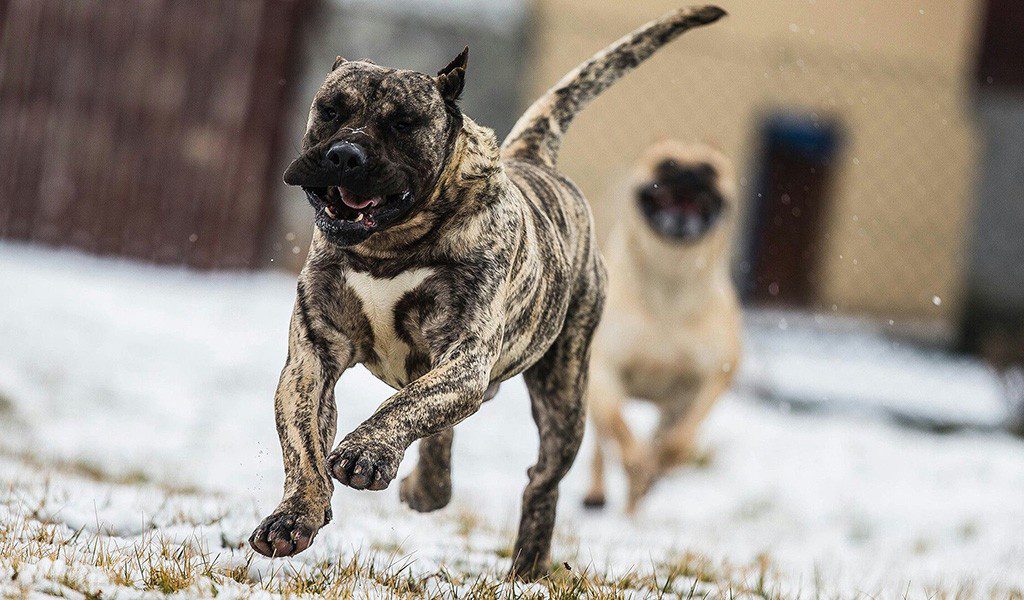
The Dogo Canario is a balanced, albeit slightly suspicious, brutal, who considers it his mission to protect the peace of the family in which he lives. Restrained enough not to rush at everyone he meets, but not phlegmatic either, this Molossian guardian is always ready for a feat in the name of his master. In his free time from watchdog activities, the press canario is not averse to throwing off the burden of worries and playing with the household. Just don’t try to make him a babysitter or a delivery man for the morning papers – in these niches, the Canaries are full of more successful competitors.
History of the Dogo Canario breed
The breed originated on the islands of Tenerife and Gran Canaria. It is believed that mahorero cattle dogs, bred by the Guanches since ancient times, as well as Roman molossians, who were brought to the Canaries later, took part in the formation of the animal genotype. For a long time, the press canario freely bred in the territories of the archipelago, and the main area of \u200b\u200bits activity was the protection of the master’s property and grazing.
In the 15th century, the Spaniards appropriated the Canaries, partially exterminating, partially sending the indigenous population into captivity. The military conflict also affected the dogs. On the devastated ashes, the animals had nothing to guard, so they came up with a new job – fighting and baiting wild animals. So, the Canarian Great Danes were retrained as gladiators, who staged public performances, which at first did not differ in particular cruelty.
Aggression and suspicion came to the breed later, when its representatives were pumped through the gene pool by crossing Presa Canarios with English Bulldogs and Mastiffs brought to Tenerife . The offspring from these matings had great viciousness and reaction speed, so the Spanish authorities considered the breed dangerous, allowing it to be kept only by butchers. Individuals that belonged to owners of other professions were destroyed. The Great Danes continued their fighting career, for which they were mated with other four-legged “aggressors” like Staffords and Boxers. Subsequently, this led to the loss of the native exterior by animals and stratification into breed types.
Since the second half of the 20th century, dog fights have been banned, and the Canarian Great Dane genus fell into decline. Perhaps the breed would have disappeared if Spanish enthusiasts had not taken up its revival. Once again, the phenotype was updated for the animals, adding the genes of Rottweilers , Great Danes and Mastino Neapolitano to it, and in 1982 the National Club of Presa Canario began to work. In 1986, the first dog shows of the Canaries started in Spain, in 1989 the breed was standardized, and in 2001 its representatives were officially registered by the FCI.
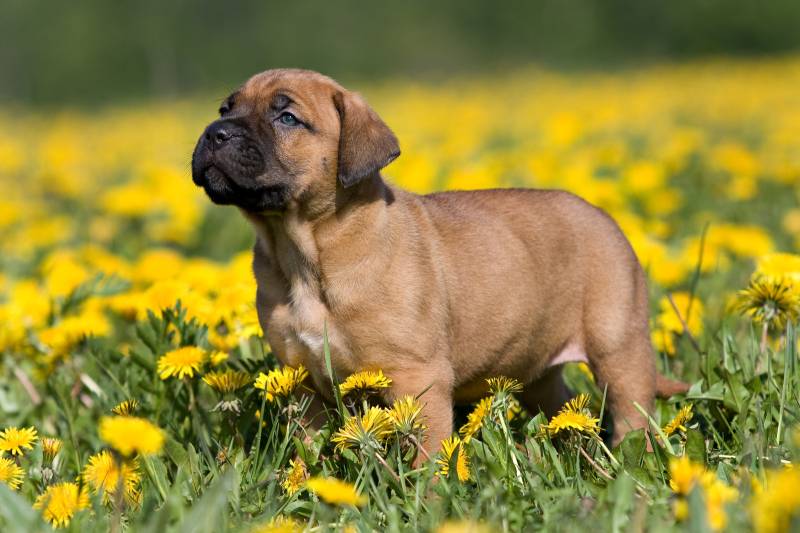
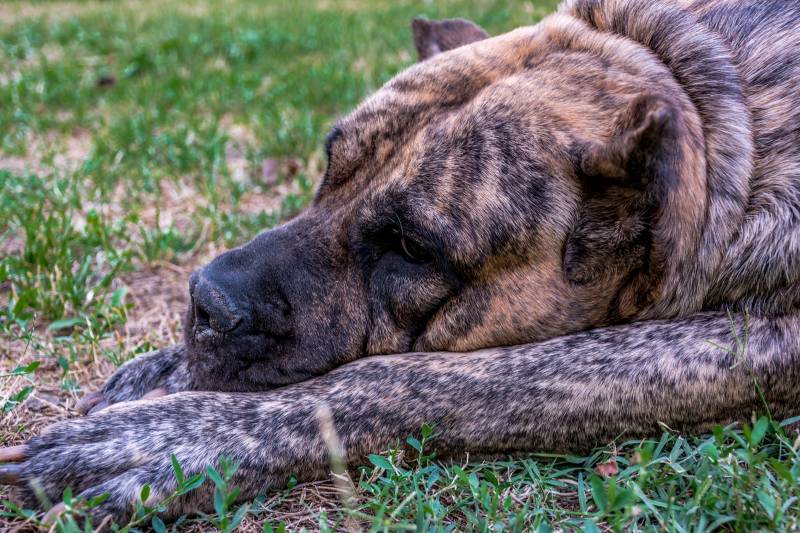
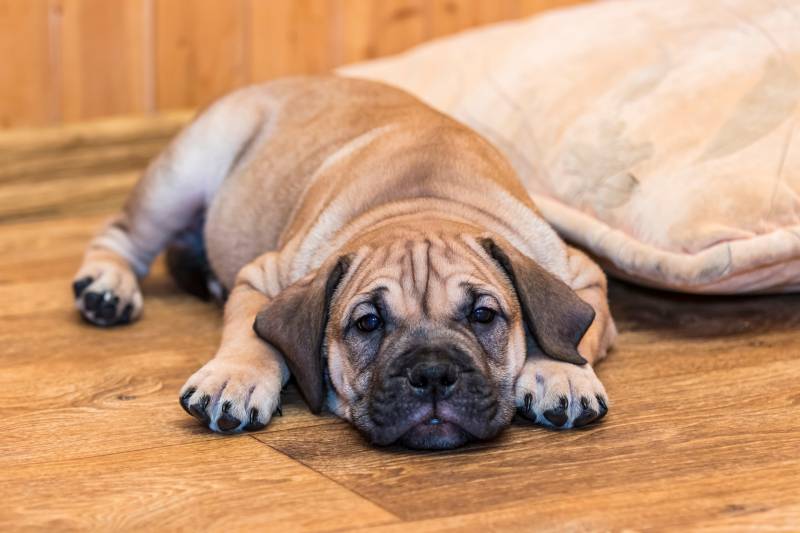
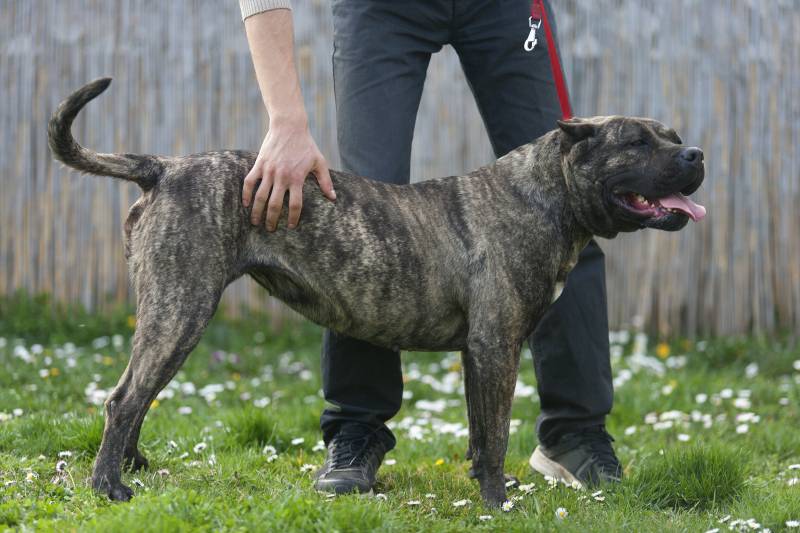
Dog breed standard
Presa canarios look like Cane Corso with their molossian-like, emphasized brutal appearance. The weight category of the breed is also serious: the correct male must increase at least 50 kg of live weight, while bitches are allowed to stop at around 40 kg. There are “girls” and other external differences. For example, females have a more stretched body format. In addition, they are much shorter than their partners: only 56-61 cm compared to 64-68 cm, observed in males. Add texture and charisma to the breed “wild” tiger color, as well as small folds of skin on the muzzle, reminiscent of mastiff ancestors.
Head
The strong massive head of the Dogo Canario has the shape of an elongated cube. The ratio of the length of the skull to the muzzle is approximately 60:40. The skull is moderately domed with prominent cheekbones, a flattened occiput, and loosely hanging skin. The stop is quite noticeable, but not steep, with a well-defined middle crease. A characteristic feature of the breed is a flat, straight muzzle with a wide base, only slightly tapering at the tip.
Teeth, jaws, lips
When in contact with each other, the lips take the form of an inverted V, while the upper lips hang down slightly. The jaws are massive with developed fangs, large molars and relatively small front teeth. Standard bite types are scissor and tight bite. The direct closure of the jaws is acceptable, but undesirable, since it contributes to the erasure of the teeth.
Nose
A brightly pigmented lobe with large nostrils is stretched in width. The front of the nose protrudes slightly above the dog’s lips.
Eyes
The Dogo Canario has large or medium-sized eyes of a harmonious fit – that is, not protruding, but not deeply located either. Eyeballs cover dense, brightly pigmented eyelids. The classic color of the iris is from chestnut to dark brown.
Ears
Ears hanging loosely on the sides of the skull are far apart. The ear cloth itself is small in size, closely adjacent to the head and, when folded, resembles a pink petal. Often, the ears are stopped, in which case the organ takes the correct standing position.
Neck
The neck of the Dogo Canario resembles a cylinder with excellently developed muscles and a slight dewlap in the front.
Frame
The body of a purebred individual should be massive, strong and exceed the length of the animal at the withers by at least 18-20%. The back is straight, but with a slight rise between the croup and the withers. The croup of the dogs is developed, and this part of the body looks more massive in bitches. A mandatory requirement of the breed standard is a wide chest with strongly arched ribs and a slightly tucked-up belly line.
limbs
Dogo Canarios have muscular, parallel limbs that provide a springy, long stride when moving. The shoulders of the breed are set at the right angle, the elbows are without eversion to the sides, the pasterns are massive with a slight bend. When viewed from behind and from the sides, the thighs of the animal look elongated and muscular, and the hocks are low. All four feet have tight, rounded toes and hard black pads, the forelegs being shorter than the hind feet. Claws – necessarily black.
Tail
The tail of the Dogo Canario has a medium fit, it is very massive at the base and narrowed at the tip. In a calm dog, the tail is lowered, but does not reach the hocks; in the excited, it takes on a saber shape, rises in the direction of the back, but never twists.
Wool
Formally, the “Canaries” do not have an undercoat, but in practice it can be found in the cervical and gluteal regions. The outer coat is short, even and hard. The coat is longer on the hips and withers, the shortest on the outside of the ears.
Color
The traditional colors of the breed are all types of brindle: from light gray to warm shades. Additionally, the standard allows the breeding of fawn and sand colors. There is a black mask on the face of the Dogo Canario. In addition, there may be contrasting white markings on the neck and toes, which are undesirable.
Faults and disqualifying vices
The ideal show pet must fit into the parameters set by the standard in all respects. If the dog has noticeable defects in appearance, such as a general fragility of appearance, an atypical skull shape and disturbed proportions, this will greatly affect the exhibition score. As for the ban on exhibiting, a Dogo Canario with the following appearance defects can receive it:
- heterochromia or too bright eyes;
- white marks on wool in places not specified by the standard;
- undershot;
- no black mask;
- depigmented skin of the lips, eyelids and lobes;
- keeled chest;
- cryptorchidism;
- croup below the level of the withers.
Individuals with docked tails, as well as those with atypical behavior, are not allowed for exhibitions and breeding. Usually these are overly cowardly or aggressive animals that are difficult to control in the ring.
The nature of the Canarian dog
The Presa Canarios are no longer gladiators or game hunters, but their territorial instinct is still strong. That is why it is better to acquire a Canary dog when there is a need for a defender and a sensitive watchman. In everyday life, tiger “pitching” is quite balanced and calm, but they do not fall out of reality, preferring to keep the situation under control. Hence – distrust of strangers and suspicion of anyone who tries to closely contact the owner. In relations with their fellow tribesmen, Canarian dogs are reasonable and restrained, but exactly until the first provocation. As soon as the intensity of passions reaches its peak, it is unrealistic to stop the dog.
An attack without warning is not in the rules of a presa canario, so if the animal growled, stood up and showed fangs, this signals that it is time to immediately retire. Running from the natives of Tenerife is not recommended in principle, if you do not want to provoke the dog to more drastic measures. Dogs of the Canary Islands have a peaceful and trusting relationship with children. A formidable “bodyguard” can allow a lot for kids, so if you see a dog sledding children, this is not a staged show, but quite an ordinary phenomenon for a family in which the dog and children trust each other. However, you should not recklessly rely on the patience of an animal: for all their love of children, the Canarian Great Danes are not included in the top four-legged nannies where you can leave kids.
The breed does not compete for spheres of influence with other pets, especially if these same pets are inferior to Great Danes in size. When acquiring a Presa Canario puppy, it is not necessary to evict cats and dogs of decorative breeds from the house. Living side by side, the animals gradually get used to each other and do not conflict. To find out who is in charge in the house, Canarian dogs prefer among themselves, so if you plan to become the owner of two males or females, get ready for friction between the wards. In everyday life, the descendants of the Roman Molossians are unpretentious, in the absence of the owner’s desire to communicate, they easily merge with the interior. Another distinguishing feature of the breed is a slight stubbornness that you just need to accept.
Education training
The Dogo Canario is a dog for which early socialization is important. Whatever the inhabitants say about the bloodthirstiness of the breed, in 9 cases out of 10 it is due to the incorrect integration of the animal into the home and street environment. All the work of accustoming the puppy to the sounds, smells and surprises of the world falls on the shoulders of the owner, as well as the responsibility for the behavior of the pet. So get ready to work hard before you get a well-mannered and unflappable guardian, and not an explosive aggressor who creates problems with others and the law.
Inexperienced owners mistakenly understand under socialization the ability of the Canary dog to join the canine team, as well as the cultivation of the habit of not being afraid of harsh sounds, public transport and other external stimuli. As a result: on the very first walks, the puppy is trying to “make friends” with fellow tribesmen resting nearby, instead of independently occupied with explaining common truths to the baby. Remember, in the first months of life, a man, not relatives, remains a mentor and parent for a dog. It is with the owner that the baby should walk and obey him.
Attempts to replace the authority of the owner with participation in the educational process of other family members are not counted. There must be only one teacher, otherwise the Canarian dog will quickly realize that there is no leader in the house, and will derive its own benefit from the situation. By the way, about the dominant features of the breed: they are extremely pronounced in adolescence, although, having matured, the “Canarian” no, no, and even tries to imagine himself a superman. In this regard, the dog will have to be regularly reminded that he is not the center of the universe.
Do not forget that the dog should never enter and leave the apartment in front of the person. Attempts to grumble and bite when the owner takes the toy away should be stopped immediately (take it away, but do not scream or hit the puppy). Do not let your pet lie on the bed, and also prevent your access to any of the rooms of the house. By not stopping such behavior, you equate the animal with yourself in rights, which stimulates it to further disobedience.
Dogo Canaries are trained according to the same methods as all leader dogs. Practice basic commands like “Sit!”, “Walk!”, “Place!” even a novice owner is able, since the breed has excellent memory and quick wits. To ensure the safety of others and the ability to appear with a dog in public places, it is enough to take UGS and OKD courses. If a sports career is planned for the “Canarian”, it is worth being like training grounds with him. Dogs involved in sports should work on automatism and immediately execute commands.
Important: you can use the Canary Dog in sports disciplines no earlier than the animal is one year old. Like most large breeds, the Presa Canarios do not have very strong joints, so exercising too early is detrimental to their health.
If you wish, you can also try complex training, which allows you to form the skills of obedience and protection of the owner in the Dogo Canario. The ideal option is to allow yourself and the puppy individual lessons with a cynologist. A professional will quickly determine the pet’s psychotype, select methods of managing it and give useful advice on suitable training methods.
Maintenance and care
Since Canarian Great Danes come from a tropical climate, it is difficult for them to put up with Russian weather realities. For this reason, cynologists recommend keeping the breed in houses and apartments, allowing relocation to an aviary or yard for the summer. Otherwise, the natives of Tenerife are undemanding pets, which are enough to be provided with a separate bed, bowls for food and drink, and a couple of toys. By and large, the dog doesn’t need the rest of the “stuff”. The only caveat: consider the size of the breed and pick up larger toys so that the animal does not have the opportunity to swallow them. It is better to throw out spoiled and bitten things of the Dogo Canario without regret. If the tiger “athlete” managed to gut the toy, there is a risk that he will be able to swallow a piece of plastic or rubber,
paddock
The Great Dane is not as pronounced brachycephalic as, for example, the English Bulldog , which does not prevent him from suffering from excessive heat. In the summer heat, you need to walk with your pet less, transferring the promenades to the early morning and late evening. Despite the fact that the Presa Canario is not included in the Russian list of potentially dangerous breeds, it is recommended to take the dog to public places on a leash and in a muzzle, and individuals who have flawlessly passed the obedience standards must also wear “equipment”. Harnesses with weights, which are sometimes recommended for walking large breeds, are better not to use in the case of the Canaries. The descendants of the Roman Molossians are already heavy dogs, they do not need an extra load on the joints and spine.
Free range is possible in a private fenced area, as well as in deserted places, for example, in wastelands or in a forest. Forethought is also important. Sometimes clashes with ill-mannered wards of other dog owners lead not only to conflict between owners, but also to injuries to pets. If you see that a shrill decorative fluffy or an aggressive “Caucasian” is walking nearby, move away with your pet. Canary Great Danes almost never provoke a fight, but they do not intend to give in to presumptuous fellow tribesmen.
Hygiene
Caring for the short coat of the Canary Dog is easy: dogs are washed every 3-6 months, and twice a week they go through the coat with a brush or rubber mitten to collect dead hairs and massage the skin. Formally, the breed is devoid of undercoat, but in practice it is often found on the neck and hips of the dog, so it is better to strip these areas periodically, that is, pluck out the dead downy layer by hand.
Shearing the breed is not regulated by the standard, but in the United States it is customary to cut the Canaries. Basically, these manipulations are performed with show individuals: a haircut helps to emphasize the ideal parts of the figure, diverting the attention of the evaluation commission from the less “successful” parts of the body. Buying dog cosmetics like conditioners and coat sprays is also relevant for owners of show dogs. But if there is a desire to give the pet’s “suit” more shine without spending extra money, a solution of table vinegar, vodka and water will do the job perfectly. It is enough to moisten a cloth in it and run it over the wool.
Once a week, take the time to examine your dog’s ears. If dirt or excess sulfur is found inside the funnel, they should be removed with a clean cloth soaked in phytolotion, or with ear cleaning drops. Eyes should be examined daily, rubbing them a couple of times a week with a cloth moistened with strong tea infusion or chamomile decoction. In addition, every month the Dogo Canario needs to shorten its claws, which is more convenient to do with a nail cutter for large breeds.
Brushing your teeth is also one of the mandatory procedures, which will have to be organized at least twice a week. If you don’t risk brushing your Canary Dog’s teeth yourself, buy oral sprays and gels. It is enough to partially apply them to the teeth of the animal – then, mixing with saliva, the funds are independently distributed in the mouth. Store-bought hard treats and natural tomato juice clean the plaque well.
Feeding
The main source of protein in the Dogo Canario diet should be lean, sinewy meat with plenty of cartilage. A couple of times a week, it is useful to replace the meat part with frozen fish fillets or offal (liver, kidneys, heart, lungs), not forgetting to increase the serving size due to the reduced nutritional value of these products. By the way, in order to satisfy the appetite of such a large dog as the Canarian dog, it is better to cook cereals with meat – buckwheat, oatmeal, rice.
Milk for adults “Canarians” is impossible – it is not absorbed by the body. But buttermilk, fat-free kefir and cottage cheese are allowed. For puppies and teenagers, poultry meat is suitable because it is rich in amino acids. But in this case, it is important to know that the dog is completely healthy, since there are diseases in which any bird is contraindicated. In addition, breeders recommend introducing dietary supplements with chondroitin and glucosamine into the feed of young individuals, which helps to avoid joint problems that often occur in teenage Great Danes.
Chicken eggs and algae are also sources of useful microelements and vitamins. Be sure to include vegetables in the menu of the Dogo Canario. For example, cabbage and beets must undergo heat treatment, but carrot chips are allowed to be given raw. You can diversify the dog’s diet with fresh berries and rye bread crackers. It is easy to satisfy the body’s need for fats with butter and unrefined vegetable oils, but it is important not to overdo it so as not to cause indigestion.
It will be necessary to determine which dry food is suitable for the Canary Dog by the selection method, so mistakes and blunders in this matter are inevitable. If you don’t feel like experimenting on a four-legged friend, try leaving it on the “drying” that the breeder who sold you the dog bought – sometimes this method works. And of course, do not save on the animal by choosing budget brands. Not only do cheap feeds contain virtually no meat, they also provoke problems with digestion and kidneys.
Health and disease of the Canaries
The most common disease of the Dogo Canarias is hip and elbow dysplasia. The disease is inherited from parents, so early diagnosis of manufacturers is an important nuance that should not be overlooked. Sometimes representatives of the breed are diagnosed with Wobbler syndrome, epilepsy and multifocal retinopathy, but this does not happen as often as in the case of dysplasia. Another important feature of presa canario is the tendency to torsion of the intestines and stomach. Usually this is due to overfeeding, as well as non-compliance with the regimen (walking and sports training immediately after eating). Otherwise, the Canarian Great Danes are quite healthy and strong creatures, with caring care, living no less than other large breeds, that is, up to 10-12 years.
How to choose a puppy
- Make sure litter sires are successfully tested for genetic joint dysplasia.
- Try to get as much information as possible about the puppy’s ancestors from the seller. Do not forget that Great Danes continue to exist in different breed types, differing both in appearance and temperament.
- Among breeders, offspring of Spanish and Polish lines are especially valued, so if you are offered a puppy from “Poles” or “Spaniards” – this is a big plus.
- Since it is easy for an inexperienced owner to confuse a Dogo Canario with a Cane Corso , it is better to go with a breed specialist for the first acquaintance with a puppy and a seller.
- If possible, get to know all the animals from the litter and test them for courage – whether they are afraid of the presence of a stranger, how they react to harsh sounds. Give preference to moderately bold, inquisitive, but not aggressive kids.
- Ask the breeder to show the breeding bitch. It is from the parent that puppies often inherit their character traits and habits.
Dogo Canario price
The breed is considered rare not only in Russia, but also in the world, hence the impressive price tag for purebred puppies and the difficulty in finding a reliable nursery. As an example: presa canario from American breeders will cost 2000-4000 dollars, which is equivalent to 2500$ – 5200$. In CIS kennels, prices are more modest, so you can buy a healthy Dogo Canario puppy from sellers from Russia, Kazakhstan and Belarus for an average of 800 – 1000$.





